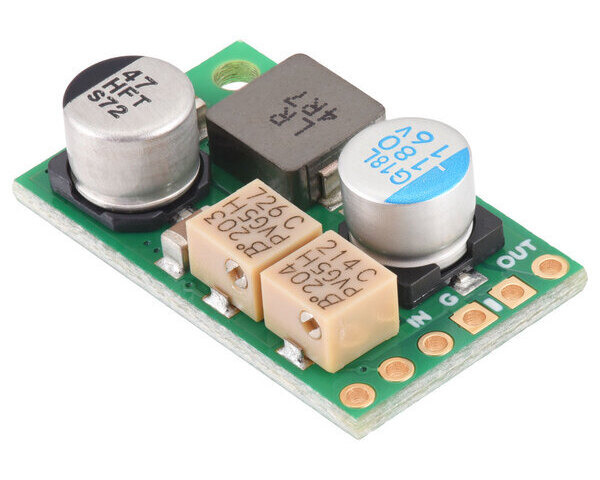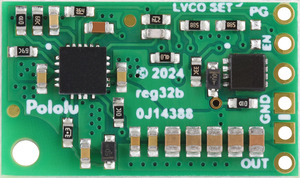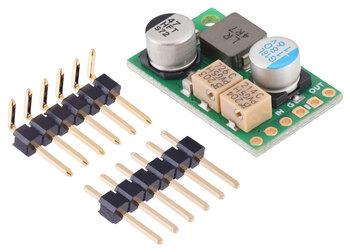Step-Down (Buck) Voltage Regulators » D30V3x Step-Down Voltage Regulators » D30V30MAx Fine-Adjust Voltage Regulators »
4.2-15V, 3A Fine-Adjust Step-Down Voltage Regulator w/ Adjustable Low-Voltage Cutoff D30V30MASCMA
| Output voltage range | Typical max output current1 | Input voltage range2 | Low-voltage cutoff |
|---|---|---|---|
| 4.2 V – 15 V | 3 A | 4.2 V – 45 V | adjustable |
Note 1: Typical continuous output current at 30 V in and 9 V out. Actual achievable continuous output current is a function of input and output voltages and is limited by thermal dissipation. See the output current graph on the product page for more information.
Note 2: Input voltage must be higher than the output voltage and is subject to dropout voltage considerations; see the dropout voltage section of product pages for more information.
Alternatives available with variations in these parameter(s): output type Select variant…
 Compare all products in D30V30MAx Fine-Adjust Voltage Regulators.
Compare all products in D30V30MAx Fine-Adjust Voltage Regulators.
| Description | Specs (13) | Pictures (19) | Resources (3) | FAQs (0) | On the blog (0) | Distributors (24) |
|---|
Overview
The D30V3x line of synchronous buck (step-down) voltage regulators generates lower output voltages from input voltages as high as 45 V. They are switching regulators (also called switched-mode power supplies (SMPS) or DC-to-DC converters), which makes them much more efficient than linear voltage regulators, especially when the difference between the input and output voltage is large. These regulators can typically support continuous output currents between 1 A and 4.5 A, depending on the input voltage and output voltage. In general, the available output current decreases as the input and output voltages increase.
 |
D30V3x line of step-down voltage regulators. From left to right: D30V30Fx, D30V30MASx, D30V33MASx. |
|---|
This line consists of the D30V30Fx family of fixed output voltages ranging from 3.3 V to 15 V and two families of adjustable versions that allow the output voltage to be set with a precision 11-turn potentiometer. Each adjustable option is available with or without an adjustable low-voltage cutoff (also set through a precision 11-turn potentiometer on the versions that have it). The adjustable families are the D30V30MAx, which is the more compact of the two thanks to its double-sided assembly, and the D30V33MAx, which includes larger through-holes for terminal blocks and can do slightly more current thanks to its larger surface area. The following table shows all of the members of the D30V3x line:
| Regulator | Output voltage | Typical max output current1 |
Input voltage2 | Adjustable low-voltage cutoff |
Size | Price |
|---|---|---|---|---|---|---|
| #4891: D30V30F3 | 3.3 V | 3.7 A | 3.3 V – 45 V | – | 0.7″ × 0.8″ | $15.95 |
| #4892: D30V30F5 | 5 V | 3.4 A | 5 V – 45 V | $15.95 | ||
| #4893: D30V30F6 | 6 V | 3.3 A | 6 V – 45 V | $16.95 | ||
| #4894: D30V30F7 | 7.5 V | 3 A | 7.5 V – 45 V | $16.95 | ||
| #4895: D30V30F9 | 9 V | 2.9 A | 9 V – 45 V | $16.95 | ||
| #4896: D30V30F12 | 12 V | 2.8 A | 12 V – 45 V | $16.95 | ||
| #4897: D30V30F15 | 15 V | 2.7 A | 15 V – 45 V | $16.95 | ||
| #4873: D30V30MAL | 1.4 V – 7 V | 3.4 A | 3.3 V – 45 V | – | 0.6″ × 1.0″ | $21.95 |
| #4872: D30V30MALCMA | $25.95 | |||||
| #4875: D30V30MAS | 4.2 V – 15 V | 3 A | 4.2 V – 45 V | – | $21.95 | |
| #4874: D30V30MASCMA | $25.95 | |||||
| #4853: D30V33MAL | 1.4 V – 7 V | 3.8 A | 3.3 V – 45 V | – | 0.9″ × 1.2″ | $22.95 |
| #4852: D30V33MALCMA | $26.95 | |||||
| #4855: D30V33MAS | 4.2 V – 15 V | 3.3 A | 4.2 V – 45 V | – | $22.95 | |
| #4854: D30V33MASCMA | $26.95 | |||||
| Note 1: At 30 V in. Actual achievable continuous output current is a function of input and output voltages and is limited by thermal dissipation. | ||||||
| Note 2: Operating voltage must be higher than the set output voltage and is subject to dropout voltage considerations. | ||||||
The regulators have reverse voltage protection up to 40 V, input under-voltage lockout, over-current protection, and short-circuit protection. A thermal shutdown feature also helps prevent damage from overheating and a soft-start feature limits the inrush current and gradually ramps the output voltage on startup.
If you need higher input voltages, consider the similar D36V28Fx family, which works up to 50 V in, and if you need more output current, consider the similar D36V50Fx family of step-down voltage regulators.
We manufacture these boards in-house at our Las Vegas facility, which gives us the flexibility to make these regulators with customized components to better meet the needs of your project. For example, if you have an application where the input voltage will always be below 20 V and efficiency is very important, we can make these regulators a bit more efficient at high loads by replacing the 40V reverse voltage protection MOSFET with a 20V one. We can also customize the output voltage. If you are interested in customization, please contact us for a quote.
Details for item #4874
This item is the D30V30MASCMA, which has an adjustable output voltage (4.2 V to 15 V) and an adjustable low-voltage cutoff (see the D30V30MAS for a version of this regulator with no low-voltage cutoff, and see the D30V30MALCMA for a version of this regulator with a lower output voltage range):
 |
Features
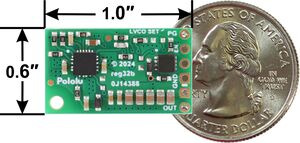 |
- Input voltage: VOUT to 45 V (input must be higher than the output voltage and is subject to dropout voltage considerations; see the dropout voltage section for details)
- Output voltage: 4.2 V to 15 V (precision-adjustable using built-in 11-turn potentiometer)
- Typical maximum continuous output current: 1 A to 4 A (see the maximum continuous output current graph below)
- Configurable low-voltage cutoff threshold (precision-adjustable using built-in 11-turn potentiometer)
- Typical efficiency of 80% to 95%, depending on input voltage, output voltage, and load (see the efficiency graphs below)
- Very low dropout voltage
- Switching frequency: ~700 kHz under heavy loads
- Power-save mode that increases light load efficiency by reducing switching frequency
- Low quiescent current (see the quiescent current graph below)
- Enable input for disconnecting the load and putting the regulator into a low-power shutdown state
- “Power good” output indicates when the regulator cannot adequately maintain the output voltage
- Frequency spread spectrum operation that lowers peak EMI noise
- Under-voltage lockout protection
- Soft-start feature limits inrush current and gradually ramps output voltage
- Integrated reverse-voltage protection up to 40 V, over-current and short-circuit protection, over-temperature shutoff
- Compact size: 0.6″ × 1.0″ × 0.355″ (15.2 mm × 25.4 mm × 9 mm); see the dimension diagram (296k pdf) for more information
- One 0.086″ mounting hole for #2 or M2 screws
Using the Regulator
Connections
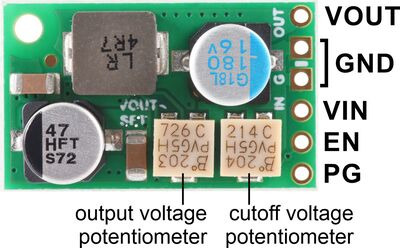 |
This regulator has six connections: power good (PG), enable (EN), input voltage (VIN), output voltage (VOUT), and two ground (GND) connections.
The “power good” indicator, PG, is an open-drain output that goes low when the regulator’s output voltage either rises more than 7.5% (typical) above or falls more than 9% (typical) below the voltage it is trying to maintain (with hysteresis). An external pull-up resistor is required to use this pin.
The EN pin is part of the low-voltage cutoff circuit. When the voltage on this pin falls below a specific threshold, the regulator enters a low-power shutdown state. This can happen when the input voltage falls below the set low-voltage cutoff threshold, or it can be externally triggered by driving the EN pin low. The shutdown current draw in this sleep mode is dominated by the low-voltage cutoff circuit (see the low-voltage cutoff section below for more information) and in the reverse-voltage protection circuit (which contributes less than 10 µA per volt on VIN). In general, the quiescent and shutdown currents are reduced by increasing the cutoff voltage threshold. (Note that for high input voltages, the shutdown current draw when it is disabled can be greater than the quiescent draw while enabled; see the quiescent current graph below for more details.)
The input voltage, VIN, powers the regulator. Voltages between 3.3 V and 45 V can be applied to VIN, but generally the effective lower limit of VIN is VOUT plus the regulator’s dropout voltage, which varies approximately linearly with the load (see below for graphs of the dropout voltage as a function of the load).
VOUT is the regulated output voltage, which can be set between 4.2 V and 15 V with the output voltage adjustment potentiometer.
Setting the output voltage
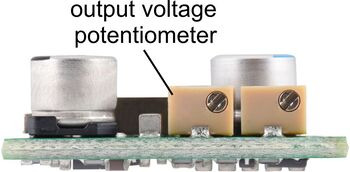 |
The output voltage is controlled with an 11-turn precision potentiometer that allows for an output range of 4.2 V and 15 V. Turning the potentiometer clockwise increases the output voltage. The regulator ships with a the voltage set to approximately 5 V by default.
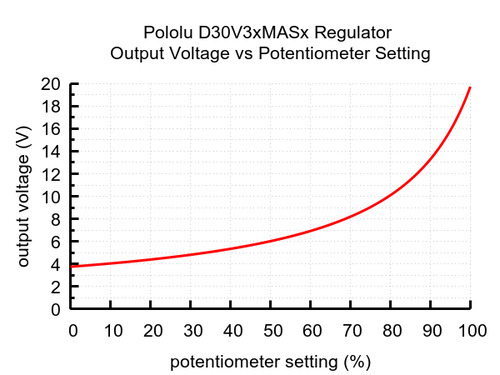 |
Warning: The output voltage adjustment range allows for voltages over 15 V, but these should not be used. Doing so could result in derated performance or damage to the regulator.
Setting the low-voltage cutoff threshold
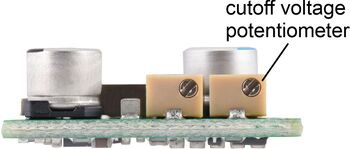 |
The low-voltage cutoff threshold is also controlled with an 11-turn precision potentiometer, and turning the potentiometer clockwise increases the cutoff voltage. The regulator ships with the cutoff voltage set below 3.5 V, low enough that it should start by default for any input voltage over 4 V. In general, the quiescent and shutdown currents are reduced by increasing the cutoff voltage threshold.
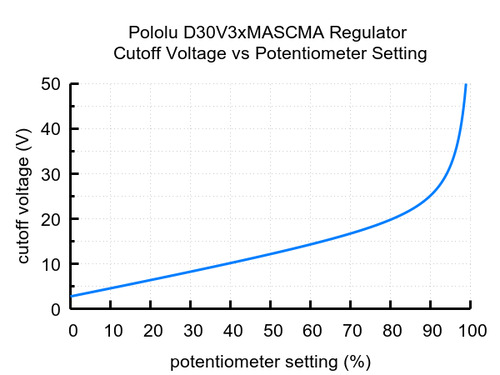 |
 |
The EN pin has a precise cutoff threshold (typically 0.85 V, but unit-to-unit variation can put it anywhere between 0.65 V and 1.05 V), and the cutoff adjustment potentiometer is part of a voltage divider circuit, as shown on the right, that determines the relationship between VIN and the voltage on EN. We have two recommended techniques for setting the cutoff voltage:
Technique A: Power the regulator at the desired cutoff voltage and, with the regulator enabled, turn the cutoff potentiometer clockwise until the regulator turns off. This is the simplest approach, and we recommend it in situations where a supply at the desired cutoff voltage is available.
Technique B:
- Power the regulator at a known voltage, VIN, above your target cutoff voltage and, with the regulator enabled, turn the cutoff potentiometer clockwise until the regulator turns off.
- Measure the voltage on the EN pin, which will be the EN cutoff threshold for your specific regulator. It will typically be around 0.85 V, but it could be as low as 0.65 V or as high as 1.05 V.
- Use the following equation to calculate what the EN voltage should be at VIN so that it reaches the cutoff threshold at your desired cutoff voltage:
``"EN" = "EN cutoff" * "VIN" / "VIN cutoff"``
- Turn the cutoff potentiometer counterclockwise until the voltage on EN equals the result of your calculation above.
- For example, let’s say you want to set the VIN cutoff to 6 V and you have determined the EN cutoff voltage threshold is 0.85 V using an input voltage, VIN, of 9 V. The following calculation tells you what to set the EN voltage to at 9 V in to achieve a 6 V cutoff:
``"EN" = "0.85 V" * "9 V" / "6 V" = "1.275 V"``
Note: There is approximately 200 mV of hysteresis on the EN threshold, which means that the activation threshold for EN rising is about 200 mV higher than the shutdown threshold for EN falling. This means that the regulator will typically require an input voltage around 125% of the cutoff voltage to begin operating.
Included hardware
|
|
The six connection through-holes are arranged on a 0.1″ grid for compatibility with solderless breadboards, connectors, and other prototyping arrangements that use a 0.1″ grid. A 6×1 straight male header strip and a 6×1 right-angle male header strip are included with the regulator.
Typical efficiency
The efficiency of a voltage regulator, defined as (Power out)/(Power in), is an important measure of its performance, especially when battery life or heat are concerns.
Maximum continuous output current
The maximum achievable output current of these regulators varies with the input voltage but also depends on other factors, including the ambient temperature, air flow, and heat sinking. The graph below shows maximum output currents that these regulators can deliver continuously at room temperature in still air and without additional heat sinking.
 |
During normal operation, this product can get hot enough to burn you. Take care when handling this product or other components connected to it.
Quiescent current
The quiescent current is the current the regulator uses just to power itself, and the graph below shows this for the different regulator versions as a function of the input voltage. The data in the graph shows the quiescent current with the low-voltage cutoff set to its minimum value of 2.7 V; in general, the quiescent (and shutdown) currents are reduced by increasing the cutoff voltage threshold.
 |
Typical dropout voltage
The dropout voltage of a step-down regulator is the minimum amount by which the input voltage must exceed the regulator’s target output voltage in order to ensure the target output can be achieved. For example, if a 5 V regulator has a 1 V dropout voltage, the input must be at least 6 V to ensure the output is the full 5 V. Generally speaking, the dropout voltage increases as the output current increases. The graph below shows the dropout voltages at several different output voltages as a function of output current:
 |
